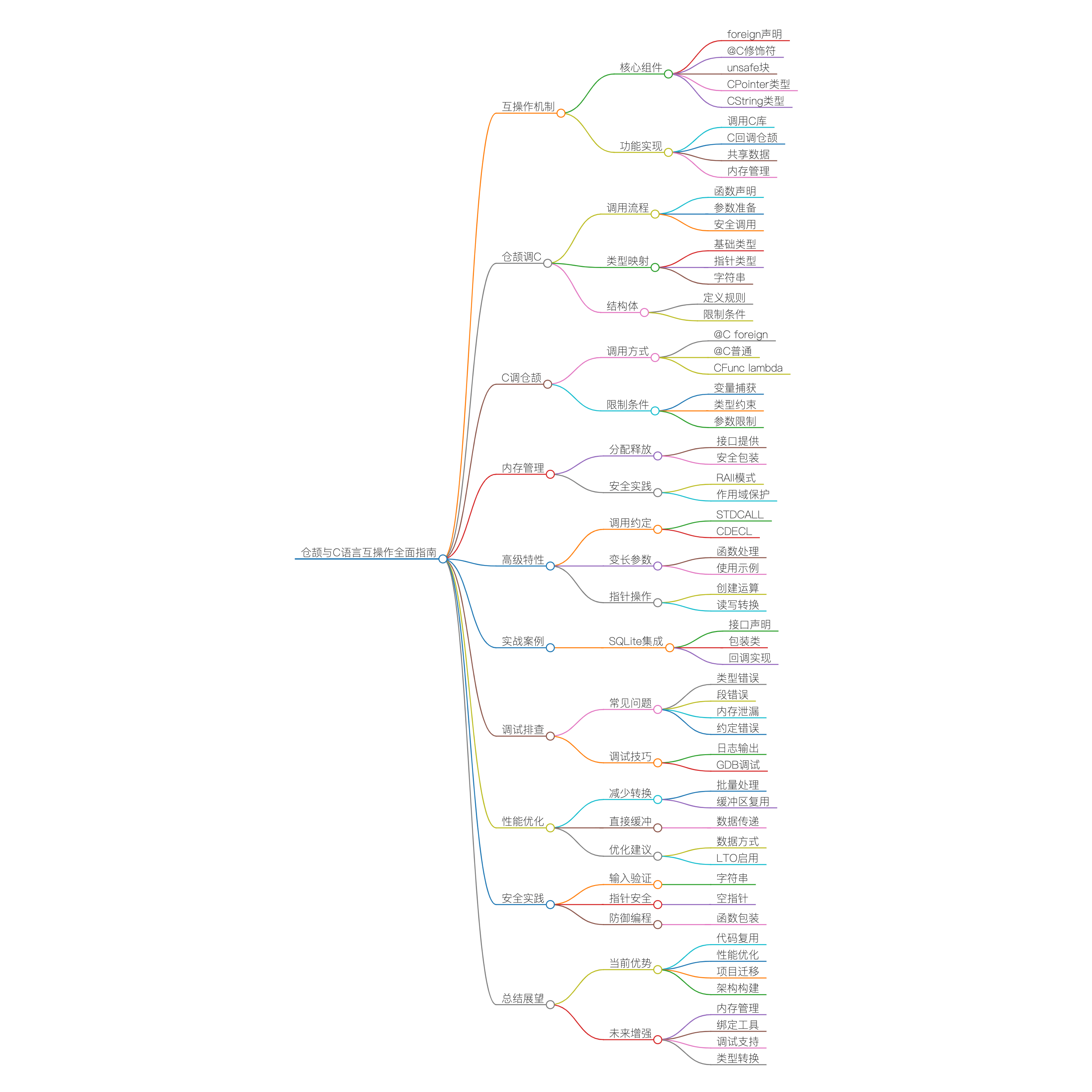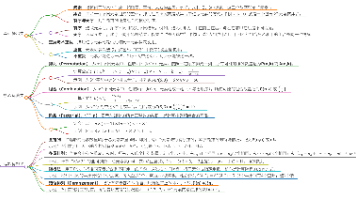仓颉与C语言互操作全面指南
·
互操作机制概述
仓颉语言通过精心设计的互操作机制实现了与C语言的无缝集成,这一功能主要通过foreign关键字、CFunc类型和一系列特殊注解实现。这种互操作能力使得仓颉可以:
- 直接调用现有的C语言库函数
- 在C代码中回调仓颉函数
- 共享复杂数据结构
- 进行底层内存管理
核心组件
- foreign声明:标记外部C函数
- @C修饰符:标识兼容C的类型和函数
- unsafe块:隔离不安全操作
- CPointer类型:对应C的指针
- CString类型:处理C风格字符串
仓颉调用C函数
基本调用流程
在仓颉中调用C函数需要三个关键步骤:
- 函数声明:使用
foreign声明C函数原型 - 参数准备:将仓颉类型转换为C兼容类型
- 安全调用:在
unsafe块中执行调用
示例:调用标准C库函数
// 声明C标准库函数 foreign func rand(): Int32 foreign func printf(format: CString, ...): Int32 main() { // 必须使用unsafe包裹调用 let randomNum = unsafe { rand() } // 处理C字符串需要额外注意内存管理 unsafe { let fmt = LibC.mallocCString("Random number: %d\n") printf(fmt, randomNum) LibC.free(fmt) // 必须手动释放内存 } } 类型映射规则
仓颉与C的类型对应关系遵循以下原则:
| 仓颉类型 | C类型 | 说明 |
|---|---|---|
Int8 |
int8_t |
8位有符号整数 |
UInt8 |
uint8_t |
8位无符号整数 |
Int32 |
int32_t |
32位有符号整数 |
Float32 |
float |
32位浮点数 |
CPointer<T> |
T* |
指向T类型的指针 |
CString |
char* |
以null结尾的字符串 |
Unit |
void |
无返回值 |
注意:
int和long等平台相关类型需要明确指定对应的仓颉类型
结构体处理
对于C中的结构体,需要在仓颉中使用@C struct定义对应的类型:
// C侧结构体 typedef struct { int x; float y; char name[32]; } Point; // 仓颉侧对应定义 @C struct Point { var x: Int32 = 0 var y: Float32 = 0.0 var name: VArray<Int8, $32> = VArray(repeat: 0) } 关键限制:
- 成员顺序必须完全一致
- 不支持柔性数组
- 不能包含指向托管内存的引用
C调用仓颉函数
仓颉提供了三种方式使C代码可以调用仓颉函数:
1. @C修饰的foreign函数
@C foreign func callbackDemo(a: Int32, b: Int32): Int32 { return a + b } 2. @C修饰的普通仓颉函数
@C func add(a: Int32, b: Int32): Int32 { println("Adding in Cangjie") return a + b } 3. CFunc类型的lambda表达式
let callback: CFunc<(Int32, Int32) -> Int32> = { a, b => println("Lambda callback") a * b } 重要限制:
- CFunc lambda不能捕获变量
- 参数和返回类型必须满足CType约束
- 不支持命名参数和默认参数
内存管理
内存分配与释放
仓颉提供了与C兼容的内存管理接口:
foreign func malloc(size: UIntNative): CPointer<Unit> foreign func free(ptr: CPointer<Unit>): Unit // 更安全的包装 public struct LibC { public static unsafe func malloc<T>(count: Int64 = 1): CPointer<T> { let size = sizeOf<T>() * count return CPointer(malloc(size)) } public static unsafe func free<T>(p: CPointer<T>): Unit { free(p.asCPointer<Unit>()) } } 内存安全实践
- 资源获取即初始化(RAII):
public class CStringResource(resource: CString) <: Resource { public func close(): Unit { unsafe { LibC.free(resource) } } } // 使用示例 let cs = unsafe { LibC.mallocCString("Hello") } try (res = CStringResource(cs)) { unsafe { printf(res.value) } } - 作用域保护:
public unsafe func withCString<T>(str: String, body: (CString) -> T): T { let cstr = LibC.mallocCString(str) try { let result = body(cstr) LibC.free(cstr) return result } catch (e) { LibC.free(cstr) throw e } } 高级互操作特性
调用约定控制
仓颉支持通过@CallingConv指定不同的调用约定:
// Windows API通常使用STDCALL @CallingConv[STDCALL] foreign func MessageBoxA( hWnd: CPointer<Unit>, text: CString, caption: CString, uType: UInt32 ): Int32 // 默认CDECL可省略 @CallingConv[CDECL] foreign func strlen(str: CString): UIntNative 变长参数支持
仓颉可以处理C的变长参数函数:
foreign func printf(format: CString, ...): Int32 // 使用示例 unsafe { let fmt = LibC.mallocCString("%d %f %s\n") printf(fmt, 42, 3.14, LibC.mallocCString("test")) LibC.free(fmt) } 指针操作
仓颉提供了丰富的指针操作API:
public func main() { // 指针创建 var ptr = CPointer<Int32>() // 指针运算 ptr = unsafe { ptr + 1 } // 前进sizeof(Int32)字节 ptr = unsafe { ptr - 1 } // 后退sizeof(Int32)字节 // 指针读写 unsafe { ptr.write(42) let value = ptr.read() println(value) } // 指针转换 let bytePtr = CPointer<Int8>(ptr) } 实战案例:集成SQLite
步骤1:声明必要的C接口
// SQLite3头文件中的关键函数 foreign func sqlite3_open(filename: CString, ppDb: CPointer<CPointer<Sqlite3>>): Int32 foreign func sqlite3_close(db: CPointer<Sqlite3>): Int32 foreign func sqlite3_exec( db: CPointer<Sqlite3>, sql: CString, callback: CFunc<(CPointer<Unit>, Int32, CPointer<CString>, CPointer<CString>) -> Int32>, data: CPointer<Unit>, errmsg: CPointer<CString> ): Int32 步骤2:定义包装类
public class Database { private var dbPtr: CPointer<Sqlite3> public init(path: String) { unsafe { let cpath = LibC.mallocCString(path) var ppDb = CPointer<CPointer<Sqlite3>>() let rc = sqlite3_open(cpath, ppDb) LibC.free(cpath) if rc != 0 { throw SQLError("Cannot open database") } this.dbPtr = ppDb.read() } } public func close(): Unit { unsafe { sqlite3_close(dbPtr) } } public func exec(sql: String): Unit { unsafe { let csql = LibC.mallocCString(sql) let rc = sqlite3_exec(dbPtr, csql, null, null, null) LibC.free(csql) if rc != 0 { throw SQLError("Execution failed") } } } } 步骤3:实现回调函数
@C foreign func queryCallback( data: CPointer<Unit>, argc: Int32, argv: CPointer<CString>, colNames: CPointer<CString> ): Int32 { unsafe { for i in 0..<argc { let value = argv[i].toString() let name = colNames[i].toString() println("${name} = ${value}") } } return 0 } 调试与问题排查
常见问题及解决方案
-
类型不匹配错误
- 检查结构体成员顺序和类型
- 验证整数类型是否匹配(如使用
Int32而非Int)
-
段错误(Segmentation Fault)
- 检查指针是否为null
- 验证内存是否已释放
- 确保指针类型转换正确
-
内存泄漏
- 使用RAII模式管理资源
- 确保每个malloc都有对应的free
-
调用约定错误
- Windows API需要指定
STDCALL - 默认使用
CDECL
- Windows API需要指定
调试技巧
- 启用详细日志:
foreign func fprintf(stream: CPointer<Unit>, format: CString, ...): Int32 foreign func stderr: CPointer<Unit> public func logDebug(msg: String): Unit { unsafe { let fmt = LibC.mallocCString("[DEBUG] %s\n") fprintf(stderr, fmt, LibC.mallocCString(msg)) LibC.free(fmt) } } - 使用GDB调试:
gdb --args ./cangjie_program break foreign_function_name 性能优化建议
-
减少边界转换:
- 批量处理数据而非单个元素
- 预分配缓冲区重复使用
-
使用直接缓冲区:
public func processBuffer(data: Array<Int32>): Unit { unsafe { let handle = acquireArrayRawData(data) let ptr = handle.pointer c_process_bulk(ptr, data.size) releaseArrayRawData(handle) } } - 选择合适的数据传递方式:
| 方式 | 适用场景 | 性能特点 |
|---|---|---|
| 值传递 | 简单标量类型 | 零拷贝,最快 |
| 指针传递 | 大型结构体/数组 | 避免拷贝,较快 |
| 回调函数 | 异步通知/事件处理 | 有一定调用开销 |
| 共享内存 | 高频大数据量交换 | 最快但需要同步 |
- 启用LTO优化:
cjc --lto=full program.cj -o program 安全最佳实践
- 输入验证:
public func safeCString(input: String): CString { if input.contains("\0") { throw IllegalArgumentException("String contains null byte") } return LibC.mallocCString(input) } - 指针安全检查:
public func safeRead[T](ptr: CPointer<T>): T { if ptr.isNull() { throw NullPointerException() } return unsafe { ptr.read() } } - 防御性编程:
foreign func dangerousCFunc(ptr: CPointer<Int32>): Unit public func safeWrapper(ptr: CPointer<Int32>): Unit { unsafe { if !ptr.isNull() { dangerousCFunc(ptr) } } } 总结与展望
仓颉与C的互操作功能强大而灵活,通过本文介绍的各种技术和模式,开发者可以:
- 安全高效地复用现有C代码库
- 在性能关键路径使用底层优化
- 逐步迁移大型C项目到仓颉
- 构建混合语言系统架构
未来可能的增强包括:
- 更智能的内存管理集成
- 自动化绑定生成工具
- 增强的调试支持
- 更丰富的类型自动转换
通过合理利用仓颉的互操作特性,开发者可以在享受现代语言特性的同时,继续保持与C生态系统的无缝集成,实现最佳的生产力和性能平衡。

更多推荐
 已为社区贡献161条内容
已为社区贡献161条内容







所有评论(0)